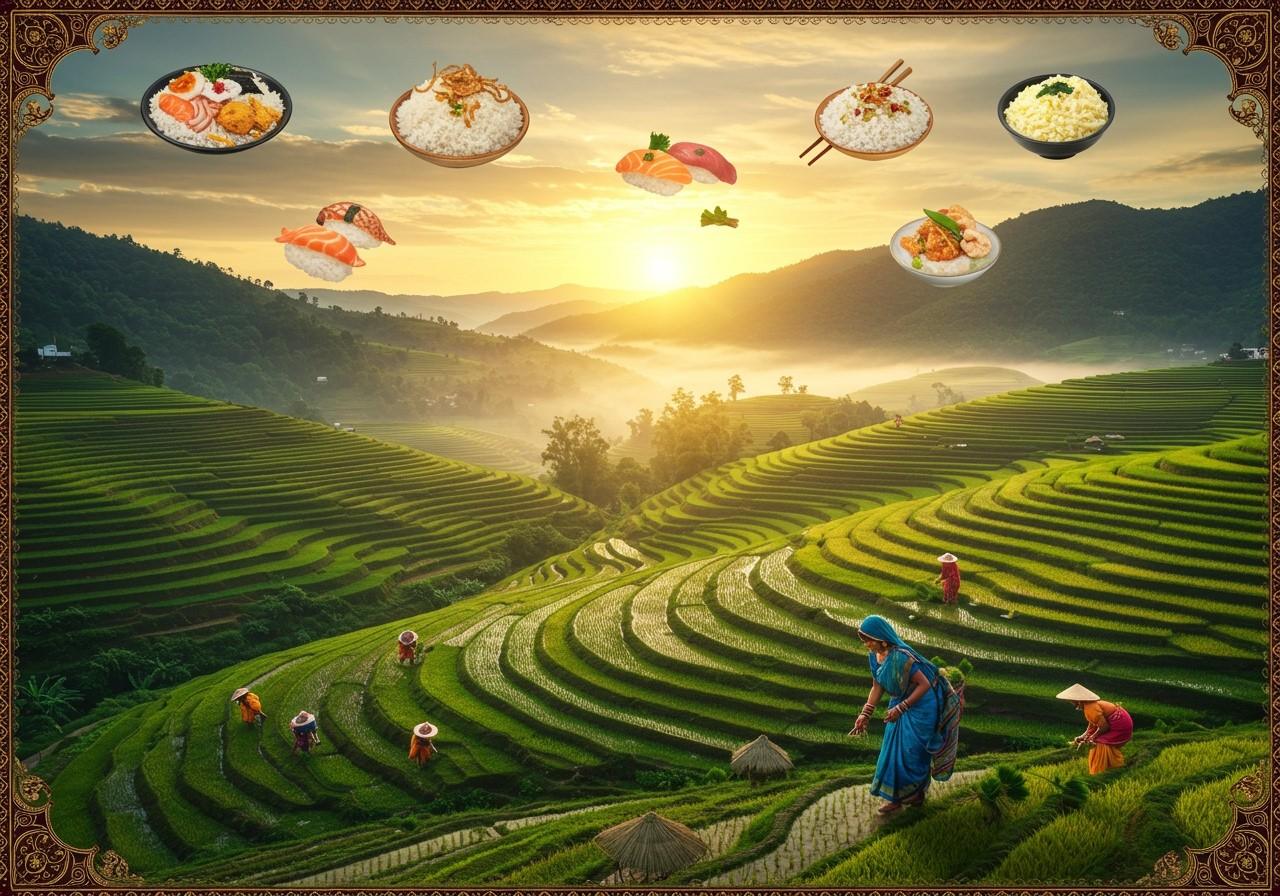
Rice, a staple food for billions, transcends its nutritional value, holding profound cultural, historical, and economic significance, especially in Asia. Deeply intertwined with social customs, religious rituals, and daily life, rice symbolizes fertility, prosperity, and life itself, often referred to as the ‘staff of life’. The historical cultivation of rice has even influenced the cultural differences between Eastern and Western societies. In this article, we explore the impact of rice cultivation on the cultures of China and Japan, delving into its historical development, cultural practices, and modern-day implications.
History of Rice Cultivation in China
Tracing the Roots of Chinese Rice Farming
Rice cultivation in China dates back to approximately 7000 BCE in the Yangtze River Valley. This fertile region provided the ideal environment for early rice farming, which quickly became integral to ancient Chinese society. Rice was not merely a food source; it played a crucial role in rituals and festivals, symbolizing prosperity and fertility. The development of sophisticated irrigation systems and the construction of rice terraces significantly enhanced farming efficiency, solidifying rice’s place as a dietary staple.
Over centuries, rice has profoundly influenced Chinese cuisine, becoming a cornerstone of culinary traditions and shaping dietary habits. Its cultural significance extends to literature and art, where it often represents abundance and prosperity. Economically, rice cultivation has impacted trade and commerce, establishing itself as a vital agricultural commodity. Modern agricultural practices continue to evolve, addressing environmental concerns like water management and promoting sustainable farming methods.
History of Rice Cultivation in Japan
Evolution of Rice Farming in Japan
Rice farming in Japan emerged during the Jomon period (10,000-300 BCE), marking a transition from hunter-gatherer lifestyles to settled agricultural communities. Rice quickly became integral to Japanese religious practices, featuring prominently in Shinto rituals and festivals. The development of unique cultivation techniques, such as flooded paddies, enabled rice to flourish in Japan’s environment.
Rice is foundational to Japanese cuisine, featuring in iconic dishes like sushi and onigiri. Its cultural importance is reflected in literature, art, and folklore, where it often symbolizes life and prosperity. Economically, rice cultivation has shaped Japan’s historical development, influencing its feudal system and taxation practices. Modern Japanese farmers, while facing contemporary challenges, continue to employ traditional methods alongside modern techniques, ensuring the continued relevance of rice in Japanese culture and diet.
Comparative Analysis
Comparing Chinese and Japanese Rice Cultivation
While both China and Japan share rich histories of rice cultivation, distinct differences exist alongside their shared reverence for this staple crop. China’s sophisticated irrigation systems contrast with Japan’s innovative flooded paddy fields, showcasing unique adaptations to different environments. Both cultures, however, revere rice, celebrating its significance through various rituals and festivals. Rice has shaped dietary habits and culinary traditions in both countries, influencing their respective cuisines in unique ways. Economically, rice cultivation has played a pivotal role, shaping trade networks in China and influencing the feudal system in Japan. In literature and art, rice serves as a recurring motif, symbolizing abundance and life. Today, both nations grapple with environmental challenges, prompting the adoption of sustainable practices in rice cultivation.
Modern Implications
Relevance of Rice Cultivation Today
The forces of urbanization and industrialization have undeniably impacted traditional rice farming in both China and Japan. Despite these societal shifts, rice remains a central component of modern diets and plays a crucial role in emerging health trends. Agricultural policies in both countries now prioritize rural development and sustainability. Farmers face ongoing challenges, including climate change, but continue to innovate, adopting new technologies while preserving traditional methods. Various initiatives aim to safeguard the cultural heritage associated with rice cultivation, recognizing its enduring importance.
Poojn.in: Supporting Your Rice-Related Rituals and Traditions
At Poojn.in, India’s largest cultural goods and services store, we recognize the sacred role of rice in Indian traditions. We offer a wide range of products to support your rice-related rituals:
- Pure Akshat (Sacred Rice): Sourced and processed with utmost care, our high-quality Akshat is perfect for all your puja needs. We ensure its purity and sanctity for religious ceremonies. Explore our Akshat collection.
- Puja Thali Sets: Our complete thali sets include designated compartments for rice offerings, facilitating traditional practices during ceremonies. These sets provide all the essentials for a reverent puja experience. Find the perfect Puja Thali set here.
- Traditional Rice Storage Containers: Preserve the sanctity of your ritual rice with our authentic copper and brass storage containers. These vessels are designed to maintain freshness and purity. Browse our traditional storage containers.
- Ritual Accessories: Enhance your rice offerings with our selection of brass spoons, cups, and other essential puja accessories. These items add to the authenticity and reverence of your rituals. Discover our range of ritual accessories.
Poojn.in offers convenient online ordering and doorstep delivery across India, ensuring easy access to these essential items. Each product is carefully packaged to maintain its purity and religious significance.
Conclusion: The Enduring Legacy of Rice Cultivation
Rice cultivation in China and Japan is more than just agriculture; it’s a cultural cornerstone shaping societies, economies, and daily life. From ancient methods to modern innovations, rice remains vital in rituals, festivals, and cuisine, symbolizing prosperity, life, and abundance. As we face the challenges of climate change and urbanization, the dedication of farmers and advancements in technology will ensure the continued flourishing of rice cultivation. This enduring legacy underscores the importance of preserving cultural heritage while embracing progress.
Explore Indian Festivals and Spirituality


